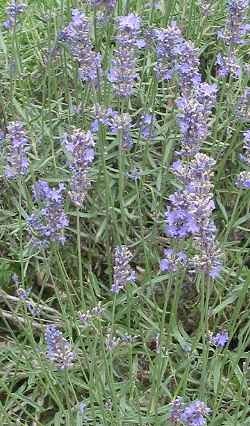
Lavandula angustifolia ssp. angustifolia at the Paris's Jardin des Plantes in June
Sunset®: 4-24
USDA: 5-9
Heat Tolerance: Resists summer heat in low deserts when established
Sun Exposure: Full sun
Origin: Western Mediterranean basin, in rocky, calcareous areas
Growth Habits: Evergreen shrub, 2 to 4 feet tall (0.6-1.2 m), and wide; narrow grey leaves, with smooth margins, up to 1.6 inches long (4 cm), woolly when juvenile
Flowers: Pink, purple or blue flowers
Watering Needs: Moderate water, well drained soil
Propagation: Softwood cuttings in spring, side shoot cuttings taken in the fall and kept in a cold frame, layering, division, since the seeds are not always germinating very well and don't come true to the varieties.
This is the lavender cultivated for the lavender essence used in perfumes, oils and soaps. The buds should be harvested just before they open.
Culture:
Plant in full sun, 12 inches apart (30 cm). Lavender do fine in somewhat infertile soils. They can be clipped to make low hedges.
Propagation:
The English Lavender has purplish blue flowers in summer, up to 0.5 inch long, on non branching stems. Some cultivars are pink or pinkish white.
Desert-Tropicals is dedicated to provide gardening advice, gardening ideas, and information about flower of all kind for landscape and collections.We try to check carefully the identification of the plants on the illustrations as well as the other information from the page, but occasionally errors do occur. if you notice anything that needs to be changed please contact us.Thanks.
© 1998-2020 Philippe Faucon, All Rights Reserved.